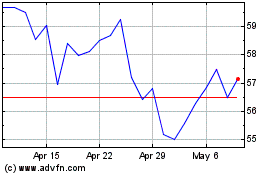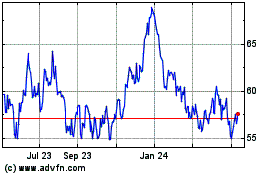Vale Acknowledges Toxic Waste in River -- Update
November 27 2015 - 4:24PM
Dow Jones News
By Paul Kiernan
RIO DE JANEIRO--Brazilian miner Vale SA acknowledged for the
first time Friday the presence of toxic elements in a river flooded
with mud and mine waste following the failure of a dam at its joint
venture, Samarco Mineração SA.
Samarco, Vale and its joint-venture partner BHP Billiton Ltd.
say the tsunami of mud unleashed in the Nov. 5 dam break was
comprised of water, mud, iron-oxide and sand, none of which are
harmful. In a news conference Friday, Vale executives continued to
stress that was the case. But Vania Somavilla, Vale's executive
director of human relations, health and safety, sustainability and
energy, said at the news conference that the mud may have upset
toxic elements settled in the bed of the Rio Doce, or along its
banks.
The admission comes two days after a United Nations report
alleging "high levels of toxic heavy metals and other toxic
chemicals" in the Rio Doce and criticizing the mining companies and
the Brazilian government for their "defensive" public response to
the incident.
Brazil's government didn't immediately respond to a request for
comment on its statements this week.
Considered one of Brazil's worst environmental catastrophes, the
Samarco incident has displaced hundreds of people living alongside
the Rio Doce. Most of them lived in the village of Bento Rodrigues,
just below the dam system, which was virtually wiped out. As many
as 13 workers and local residents died when the sludge inundated
towns in the area. Another 11 are missing.
Ms. Somavilla, saying she was mainly citing a report by the
Minas Gerais state Institute of Water Management, or IGAM, said,
"In fact there was lead, arsenic--not mercury--detected in some
points along the river." She added, "When the dam breaks and that
stuff washes out the banks of the river, it could have picked up
some kind of material that was already present, from the most
diverse of origins, but they're all materials present in
nature."
The IGAM report was dated Nov. 17 but only published this week,
after prosecutors ordered IGAM to post it online.
A spokesman for IGAM said he didn't know why the institute
didn't post the report, which appeared to contradict recent
statements by the Brazilian federal government, earlier.
The 29-page document includes samples collected at 12 points
along the Rio Doce between Nov. 7 and Nov. 12, as the mud from
Samarco's dam snaked downstream.
At various collection points, the report showed record levels of
toxic metals.
Arsenic, which the World Health Organization says can cause skin
lesions, liver disease and cancer, was detected at as much as 108
times the legal maximum. Lead, which can cause brain damage, was
measured at as much as 165 times the legal maximum. Copper, linked
to gastrointestinal problems, was at as much as 75 times the limit.
Chromium, which can cause gastrointestinal disorders and
hemorrhaging, was at as much as 57 times the limit. Among the other
metals detected were nickel, cadmium, manganese and iron found at
elevated levels.
Citing "more than 40" water samples between Nov. 14 and Nov. 18,
the federal government said in an emailed statement Thursday that
"there was not an increase in the presence of heavy metals in the
water and sediments."
But tests by a municipal water agency along the river, which
were sent to the U.N. Office of the High Commissioner for Human
Rights, showed high levels of toxic metals such as arsenic on Nov.
10. This and other evidence prompted a blistering criticism of BHP,
Vale and the Brazilian government by U.N. special rapporteurs John
Knox and Baskut Tuncak on Wednesday.
"This is not the time for defensive posturing," Messrs. Knox and
Tuncak said, "It is not acceptable that it has taken three weeks
for information about the toxic risks of the mining disaster to
surface."
Write to Paul Kiernan at paul.kiernan@wsj.com
Subscribe to WSJ: http://online.wsj.com?mod=djnwires
(END) Dow Jones Newswires
November 27, 2015 16:09 ET (21:09 GMT)
Copyright (c) 2015 Dow Jones & Company, Inc.
BHP (NYSE:BHP)
Historical Stock Chart
From Mar 2024 to Apr 2024

BHP (NYSE:BHP)
Historical Stock Chart
From Apr 2023 to Apr 2024
